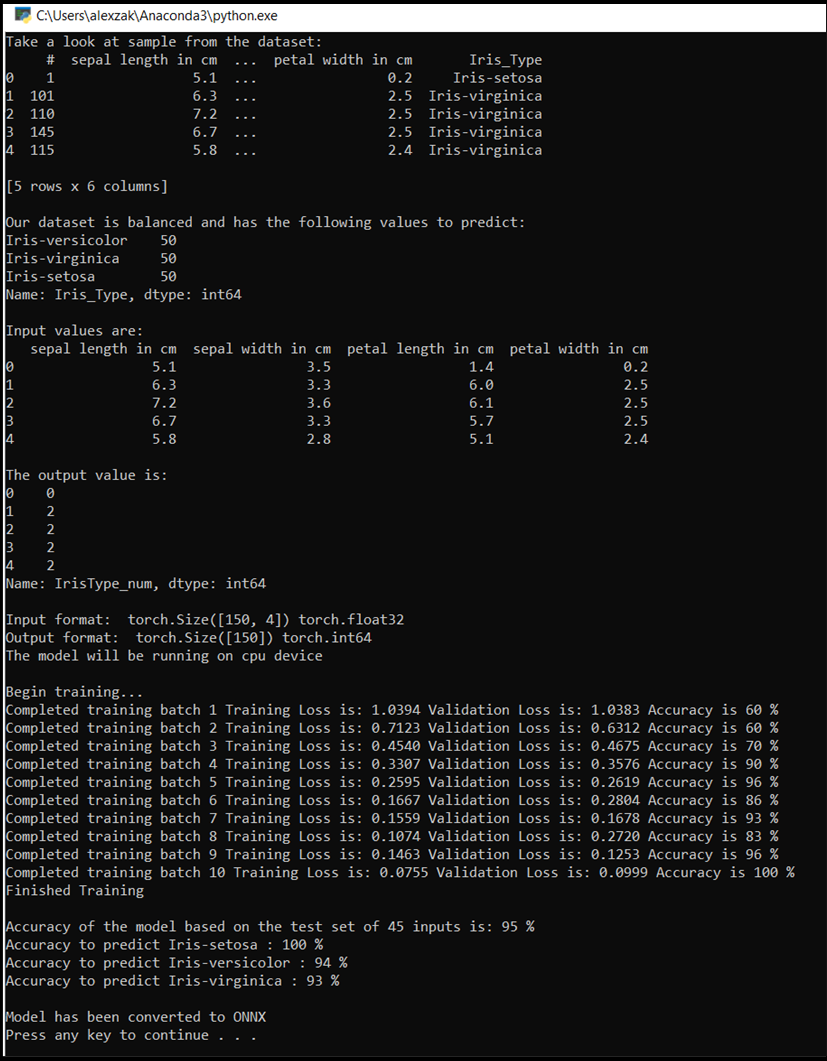在本 教學課程的上一個階段中,我們已取得我們將用來使用 PyTorch 定型數據分析模型的數據集。 現在,是時候使用該數據了。
若要使用 PyTorch 定型數據分析模型,您需要完成下列步驟:
- 載入數據。 如果您已完成本教學課程的上一個步驟,表示您已經處理過此作業。
- 定義類神經網路。
- 定義遺失函式。
- 在訓練數據上訓練模型。
- 在測試數據上測試網路。
定義類神經網路
在本教學課程中,您將建置具有三個線性圖層的基本類神經網路模型。 模型的結構如下所示:
Linear -> ReLU -> Linear -> ReLU -> Linear
線性層會將線性轉換套用至傳入數據。 您必須指定輸入特徵的數目,以及應該對應至類別數目的輸出特徵數目。
ReLU 層是一種啟用函數,用於將所有傳入特徵定義為 0 或大於 0。 因此,套用 ReLU 層時,小於 0 的任何數位會變更為零,而其他數位則維持不變。 我們會在兩個隱藏層上套用激活層,而在最後一個線性層上不會套用激活層。
模型參數
模型參數取決於我們的目標和定型數據。 輸入大小取決於我們饋送模型的功能數目, 在我們的案例中為 4 個。 輸出大小為三,因為有三種可能類型的虹膜。
有三個線性層, (4,24) -> (24,24) -> (24,3)網路會有744個權重(96+576+72)。
學習速率(lr)會設定控制您如何調整網路的權重以對應於損失梯度。 越低,訓練的速度越慢。 在本教學課程中,您會將 lr 設定為 0.01。
網路的運作方式為何?
在這裡,我們要建置轉送網路。 在訓練過程中,網路會通過所有層處理輸入、計算損失,以瞭解影像的預測標籤與正確標籤的差距,並將梯度回傳至網路,以更新層的權重。 透過逐一查看龐大的輸入數據集,網路將會「學習」設定其權數,以達到最佳結果。
正向函式會計算損失函式的值,即反向函式會計算可學習參數的梯度。 當您使用 PyTorch 建立神經網路時,只需要定義正向函式。 會自動定義回溯函式。
- 將下列程式代碼
DataClassifier.py複製到 Visual Studio 中的 檔案,以定義模型參數和神經網路。
# Define model parameters
input_size = list(input.shape)[1] # = 4. The input depends on how many features we initially feed the model. In our case, there are 4 features for every predict value
learning_rate = 0.01
output_size = len(labels) # The output is prediction results for three types of Irises.
# Define neural network
class Network(nn.Module):
def __init__(self, input_size, output_size):
super(Network, self).__init__()
self.layer1 = nn.Linear(input_size, 24)
self.layer2 = nn.Linear(24, 24)
self.layer3 = nn.Linear(24, output_size)
def forward(self, x):
x1 = F.relu(self.layer1(x))
x2 = F.relu(self.layer2(x1))
x3 = self.layer3(x2)
return x3
# Instantiate the model
model = Network(input_size, output_size)
您也必須根據電腦上的可用裝置來定義執行裝置。 PyTorch 沒有 GPU 專用連結庫,但您可以手動定義執行裝置。 如果你的計算機上有 Nvidia GPU,則裝置將是 Nvidia GPU;如果沒有,則將使用 CPU。
- 複製下列程式代碼以定義執行裝置:
# Define your execution device
device = torch.device("cuda:0" if torch.cuda.is_available() else "cpu")
print("The model will be running on", device, "device\n")
model.to(device) # Convert model parameters and buffers to CPU or Cuda
- 在最後一個步驟中,定義用來儲存模型的函式:
# Function to save the model
def saveModel():
path = "./NetModel.pth"
torch.save(model.state_dict(), path)
備註
有興趣深入瞭解使用 PyTorch 的類神經網路嗎? 請參閱 PyTorch 檔。
定義遺失函式
損失函式會計算估計輸出距離目標距離的值。 主要目標是透過神經網路中的反向傳播調整加權向量值,以減少損失函式的值。
損失值與模型精確度不同。 損失函數表示我們的模型在訓練集上每次優化迭代後的表現。 模型的精確度會計算在測試數據上,並顯示正確預測的百分比。
在 PyTorch 中,類神經網路套件包含各種損失函式,形成深度神經網路的建置組塊。 如果您想要深入了解這些細節,請參考上述註記。 在這裡,我們將使用針對這類分類進行優化的現有函式,並使用分類交叉熵損失函式和 Adam 優化器。 在優化器中,學習率(lr)控制著您在根據損失梯度調整網路權重的程度。 您將在這裡將它設定為 0.001 - 值越低,訓練速度會比較慢。
- 將下列程式代碼
DataClassifier.py複製到 Visual Studio 中的 檔案,以定義遺失函式和優化器。
# Define the loss function with Classification Cross-Entropy loss and an optimizer with Adam optimizer
loss_fn = nn.CrossEntropyLoss()
optimizer = Adam(model.parameters(), lr=0.001, weight_decay=0.0001)
在訓練數據上訓練模型。
若要訓練模型,您必須遍歷我們的資料迭代器,將輸入饋送至神經網路並進行優化。 若要驗證結果,您只需在每次訓練迭代之後,將預測的標籤與驗證數據集中的實際標籤進行比較。
程序會顯示每個 epoch 的訓練損失、驗證損失和模型的準確率,或者在訓練集上的每次完整迭代中顯示。 它會以最高的準確率來儲存模型,經過10個訓練週期後,程式會顯示最終的準確率。
- 將下列程式代碼新增至
DataClassifier.py檔案
# Training Function
def train(num_epochs):
best_accuracy = 0.0
print("Begin training...")
for epoch in range(1, num_epochs+1):
running_train_loss = 0.0
running_accuracy = 0.0
running_vall_loss = 0.0
total = 0
# Training Loop
for data in train_loader:
#for data in enumerate(train_loader, 0):
inputs, outputs = data # get the input and real species as outputs; data is a list of [inputs, outputs]
optimizer.zero_grad() # zero the parameter gradients
predicted_outputs = model(inputs) # predict output from the model
train_loss = loss_fn(predicted_outputs, outputs) # calculate loss for the predicted output
train_loss.backward() # backpropagate the loss
optimizer.step() # adjust parameters based on the calculated gradients
running_train_loss +=train_loss.item() # track the loss value
# Calculate training loss value
train_loss_value = running_train_loss/len(train_loader)
# Validation Loop
with torch.no_grad():
model.eval()
for data in validate_loader:
inputs, outputs = data
predicted_outputs = model(inputs)
val_loss = loss_fn(predicted_outputs, outputs)
# The label with the highest value will be our prediction
_, predicted = torch.max(predicted_outputs, 1)
running_vall_loss += val_loss.item()
total += outputs.size(0)
running_accuracy += (predicted == outputs).sum().item()
# Calculate validation loss value
val_loss_value = running_vall_loss/len(validate_loader)
# Calculate accuracy as the number of correct predictions in the validation batch divided by the total number of predictions done.
accuracy = (100 * running_accuracy / total)
# Save the model if the accuracy is the best
if accuracy > best_accuracy:
saveModel()
best_accuracy = accuracy
# Print the statistics of the epoch
print('Completed training batch', epoch, 'Training Loss is: %.4f' %train_loss_value, 'Validation Loss is: %.4f' %val_loss_value, 'Accuracy is %d %%' % (accuracy))
在測試數據上測試模型。
既然我們已定型模型,就可以使用測試數據集來測試模型。
我們將新增兩個測試函式。 第一個測試您在上一個部分中儲存的模型。 它會使用 45 個項目的測試數據集來測試模型,並顯示模型的精確度。 第二個是選擇性函式,用來測試模型預測三種虹膜物種中每一種的信心,其代表每個物種成功分類的機率。
- 將下列程式碼新增至
DataClassifier.py檔案。
# Function to test the model
def test():
# Load the model that we saved at the end of the training loop
model = Network(input_size, output_size)
path = "NetModel.pth"
model.load_state_dict(torch.load(path))
running_accuracy = 0
total = 0
with torch.no_grad():
for data in test_loader:
inputs, outputs = data
outputs = outputs.to(torch.float32)
predicted_outputs = model(inputs)
_, predicted = torch.max(predicted_outputs, 1)
total += outputs.size(0)
running_accuracy += (predicted == outputs).sum().item()
print('Accuracy of the model based on the test set of', test_split ,'inputs is: %d %%' % (100 * running_accuracy / total))
# Optional: Function to test which species were easier to predict
def test_species():
# Load the model that we saved at the end of the training loop
model = Network(input_size, output_size)
path = "NetModel.pth"
model.load_state_dict(torch.load(path))
labels_length = len(labels) # how many labels of Irises we have. = 3 in our database.
labels_correct = list(0. for i in range(labels_length)) # list to calculate correct labels [how many correct setosa, how many correct versicolor, how many correct virginica]
labels_total = list(0. for i in range(labels_length)) # list to keep the total # of labels per type [total setosa, total versicolor, total virginica]
with torch.no_grad():
for data in test_loader:
inputs, outputs = data
predicted_outputs = model(inputs)
_, predicted = torch.max(predicted_outputs, 1)
label_correct_running = (predicted == outputs).squeeze()
label = outputs[0]
if label_correct_running.item():
labels_correct[label] += 1
labels_total[label] += 1
label_list = list(labels.keys())
for i in range(output_size):
print('Accuracy to predict %5s : %2d %%' % (label_list[i], 100 * labels_correct[i] / labels_total[i]))
最後,讓我們新增主要程序代碼。 這會起始模型定型、儲存模型,並在畫面上顯示結果。 我們只會在訓練集上執行兩次[num_epochs = 25]迭代,因此訓練過程不會花費太長的時間。
- 將下列程式碼新增至
DataClassifier.py檔案。
if __name__ == "__main__":
num_epochs = 10
train(num_epochs)
print('Finished Training\n')
test()
test_species()
讓我們執行測試! 請確定頂端工具列中的下拉選單設定為 Debug。 如果您的裝置是64位,請將Solution Platform變更為x64,如果您的裝置是32位,請將Solution Platform變更為,以在您的本機電腦上執行專案。
- 若要執行專案,請按下
Start Debugging工具列上的按鈕,或按F5。
主控台視窗會彈出,您將會看到訓練過程。 如您所定義,將會列印每一個 Epoch 的遺失值。 預期遺失值會隨著每個迴圈而減少。
定型完成後,您應該會看到類似下面的輸出。 您的數值不會完全相同 - 訓練取決於許多因素,因此不會一律產生相同的結果,但看起來應該會類似。

後續步驟
既然我們有分類模型,下一個步驟是 將模型轉換成 ONNX 格式。